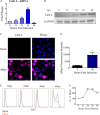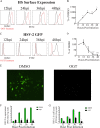Host Enzymes Heparanase and Cathepsin L Promote Herpes Simplex Virus 2 Release from Cells
- PMID: 30232188
- PMCID: PMC6232460
- DOI: 10.1128/JVI.01179-18
Host Enzymes Heparanase and Cathepsin L Promote Herpes Simplex Virus 2 Release from Cells
Abstract
Herpes simplex virus 2 (HSV-2) can productively infect many different cell types of human and nonhuman origin. Here we demonstrate interconnected roles for two host enzymes, heparanase (HPSE) and cathepsin L, in HSV-2 release from cells. In vaginal epithelial cells, HSV-2 causes heparan sulfate shedding and upregulation in HPSE levels during the productive phase of infection. We also noted increased levels of cathepsin L and show that regulation of HPSE by cathepsin L via cleavage of HPSE proenzyme is important for infection. Furthermore, inhibition of HPSE by a specific inhibitor, OGT 2115, dramatically reduces HSV-2 release from vaginal epithelial cells. Likewise, we show evidence that the inhibition of cathepsin L is detrimental to the infection. The HPSE increase after infection is mediated by an increased NF-κB nuclear localization and a resultant activation of HPSE transcription. Together these mechanisms contribute to the removal of heparan sulfate from the cell surface and thus facilitate virus release from cells.IMPORTANCE Genital infections by HSV-2 represent one of the most common sexually transmitted viral infections. The virus causes painful lesions and sores around the genitals or rectum. Intermittent release of the virus from infected tissues during sexual activities is the most common cause of transmission. At the molecular level, cell surface heparan sulfate (HS) is known to provide attachment sites for HSV-2. While the removal of HS during HSV-1 release has been shown, not much is known about the host factors and their regulators that contribute to HSV-2 release from natural target cell types. Here we suggest a role for the host enzyme heparanase in HSV-2 release. Our work reveals that in addition to the regulation of transcription by NF-κB, HPSE is also regulated posttranslationally by cathepsin L and that inhibition of heparanase activity directly affects HSV-2 release. We provide unique insights into the host mechanisms controlling HSV-2 egress and spread.
Keywords: HSV-2; heparanase; viral egress.
Copyright © 2018 American Society for Microbiology.
Figures







Similar articles
-
Role of Heparanase and Syndecan-1 in HSV-1 Release from Infected Cells.Viruses. 2022 Sep 30;14(10):2156. doi: 10.3390/v14102156. Viruses. 2022. PMID: 36298711 Free PMC article. Review.
-
Heparanase-Regulated Syndecan-1 Shedding Facilitates Herpes Simplex Virus 1 Egress.J Virol. 2020 Feb 28;94(6):e01672-19. doi: 10.1128/JVI.01672-19. Print 2020 Feb 28. J Virol. 2020. PMID: 31827001 Free PMC article.
-
Heparanase 2 Modulation Inhibits HSV-2 Replication by Regulating Heparan Sulfate.Viruses. 2024 Nov 26;16(12):1832. doi: 10.3390/v16121832. Viruses. 2024. PMID: 39772142 Free PMC article.
-
Heparanase is a host enzyme required for herpes simplex virus-1 release from cells.Nat Commun. 2015 Apr 27;6:6985. doi: 10.1038/ncomms7985. Nat Commun. 2015. PMID: 25912399 Free PMC article.
-
Heparanase, Heparan Sulfate and Viral Infection.Adv Exp Med Biol. 2020;1221:759-770. doi: 10.1007/978-3-030-34521-1_32. Adv Exp Med Biol. 2020. PMID: 32274736 Review.
Cited by
-
Incidence and Risk Factors of Bilateral Herpetic Keratitis: 2022 Update.Trop Med Infect Dis. 2022 Jun 7;7(6):92. doi: 10.3390/tropicalmed7060092. Trop Med Infect Dis. 2022. PMID: 35736971 Free PMC article. Review.
-
Heparanase, cell signaling, and viral infections.Cell Mol Life Sci. 2020 Dec;77(24):5059-5077. doi: 10.1007/s00018-020-03559-y. Epub 2020 May 27. Cell Mol Life Sci. 2020. PMID: 32462405 Free PMC article. Review.
-
Validation of Candidate Host Cell Entry Factors for Bovine Herpes Virus Type-1 Based on a Genome-Wide CRISPR Knockout Screen.Viruses. 2024 Feb 15;16(2):297. doi: 10.3390/v16020297. Viruses. 2024. PMID: 38400072 Free PMC article.
-
Role of Heparanase and Syndecan-1 in HSV-1 Release from Infected Cells.Viruses. 2022 Sep 30;14(10):2156. doi: 10.3390/v14102156. Viruses. 2022. PMID: 36298711 Free PMC article. Review.
-
Heparanase-Regulated Syndecan-1 Shedding Facilitates Herpes Simplex Virus 1 Egress.J Virol. 2020 Feb 28;94(6):e01672-19. doi: 10.1128/JVI.01672-19. Print 2020 Feb 28. J Virol. 2020. PMID: 31827001 Free PMC article.
References
-
- Xu F, Sternberg MR, Gottlieb SL, Berman SM, Markowitz LE, Forhan SE, Taylor LD. 2010. Seroprevalence of herpes simplex virus type 2 among persons aged 14–49 years—United States, 2005–2008. MMWR Morb Mortal Wkly Rep 59:456–459. - PubMed
-
- Kinghorn GR. 1993. Genital herpes: natural history and treatment of acute episodes. J Med Virol 1:33–38. - PubMed
Publication types
MeSH terms
Substances
Grants and funding
LinkOut - more resources
Full Text Sources
Other Literature Sources
Medical
Miscellaneous

